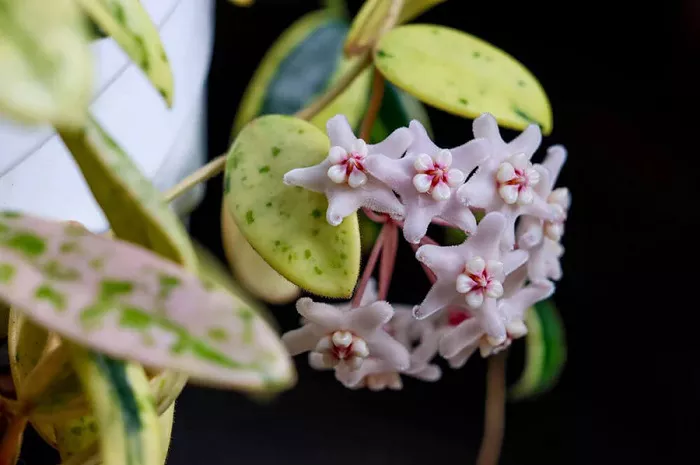Hoyas, with their waxy leaves and stunning star-shaped blooms, are beloved by gardeners for their unique beauty and low-maintenance nature. However, coaxing these charming plants to flower can sometimes be a challenge. In this article, we will explore the essential steps and tips to encourage your Hoya to produce those delightful flowers, ensuring your plant thrives and brightens up your space.
Understanding the Hoya Plant
Hoyas, commonly known as wax plants, are a diverse genus of flowering plants that thrive in tropical and subtropical climates. They are known for their thick, waxy leaves and clusters of fragrant, star-shaped flowers. These plants are not only visually appealing but also easy to care for, making them a popular choice for both novice and experienced gardeners. To get your Hoya to flower, it is crucial to understand its natural growing conditions and provide an environment that mimics its native habitat.
Optimal Growing Conditions
Light Requirements
Hoyas thrive in bright, indirect light. Place your plant near a window where it can receive plenty of sunlight without being exposed to direct rays, which can scorch its leaves. East-facing windows are ideal, as they provide gentle morning light. If you notice your Hoya’s leaves becoming pale or yellow, it may be getting too much direct sunlight. Conversely, if the leaves are small and the plant is not flowering, it might need more light. Adjusting the light conditions is a crucial step in encouraging your Hoya to bloom.
Temperature and Humidity
Hoyas are tropical plants and prefer warm temperatures and high humidity. They thrive in temperatures between 60°F and 80°F (15°C to 27°C). Avoid placing your Hoya near drafts or air conditioning vents, as sudden temperature changes can stress the plant. To increase humidity, you can place a tray of water near the plant, use a humidifier, or mist the leaves regularly. Higher humidity levels are essential for healthy growth and flower production.
Soil and Watering
Well-draining soil is vital for Hoyas. A mix of potting soil, perlite, and orchid bark works well, as it allows excess water to drain quickly, preventing root rot. Water your Hoya when the top inch of soil feels dry to the touch. Overwatering can lead to root problems, while underwatering can cause the leaves to wilt. Finding the right balance is key to keeping your plant healthy and encouraging it to flower.
Encouraging Flowering
Pruning and Training
Pruning your Hoya can help promote flowering. Remove any dead or damaged leaves and stems to encourage new growth. Be careful not to cut off the peduncles, the stems from which the flowers emerge, as Hoyas often bloom on the same peduncle year after year. Training your Hoya to climb or trail can also improve air circulation and light exposure, which are beneficial for flowering.
Fertilization
Providing the right nutrients is essential for flower production. Use a balanced, water-soluble fertilizer during the growing season, typically spring and summer. A fertilizer with a higher phosphorus content can help promote blooming. Follow the package instructions for the correct dilution and application frequency to avoid over-fertilizing, which can harm the plant.
Common Challenges and Solutions
Pests and Diseases
Hoyas are generally hardy plants, but they can be susceptible to pests like mealybugs and spider mites. Regularly inspect your plant for signs of infestation and treat any issues promptly with insecticidal soap or neem oil. Keeping the plant clean and maintaining proper humidity levels can also help prevent pest problems.
Patience and Persistence
Sometimes, despite providing the ideal conditions, your Hoya may still take its time to flower. Hoyas can be slow growers, and it may take several years for a young plant to mature and produce flowers. Be patient and consistent with your care routine. With time and the right conditions, your Hoya will reward you with its beautiful blooms.
Creating the Perfect Environment
Repotting
Repotting your Hoya every two to three years can provide fresh soil and more space for root growth. Choose a pot that is only slightly larger than the current one to avoid overpotting, which can lead to water retention and root rot. Repotting is best done in spring when the plant is actively growing.
Propagation
If you have a healthy Hoya, you can propagate it to create new plants. Stem cuttings are the most common method. Take a cutting with at least two pairs of leaves and place it in water or moist soil. Keep the cutting in a warm, bright spot and it should root within a few weeks. Propagating your Hoya not only gives you more plants but also helps maintain the health of the parent plant.
Conclusion
Getting your Hoya to flower is a rewarding experience that requires understanding the plant’s needs and providing the right environment. With proper light, temperature, humidity, and care, your Hoya will thrive and produce its stunning blooms. Be patient, observe your plant closely, and make adjustments as needed. Soon, you will enjoy the delightful fragrance and beauty of your Hoya in full bloom.


